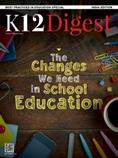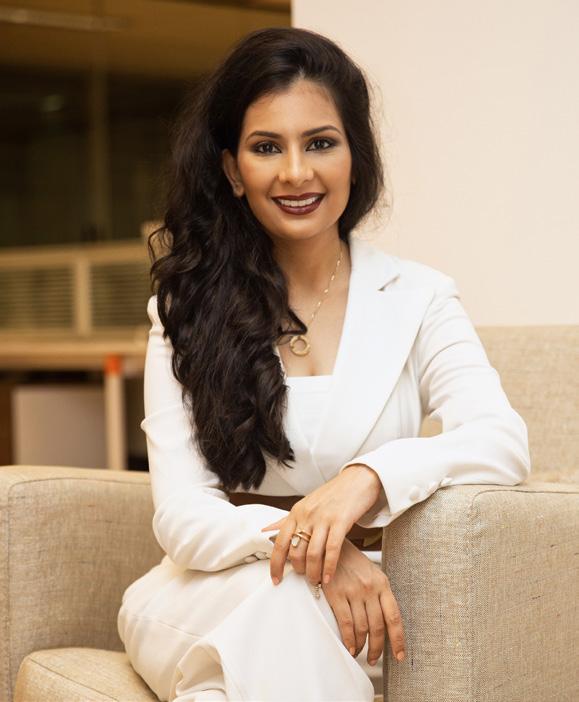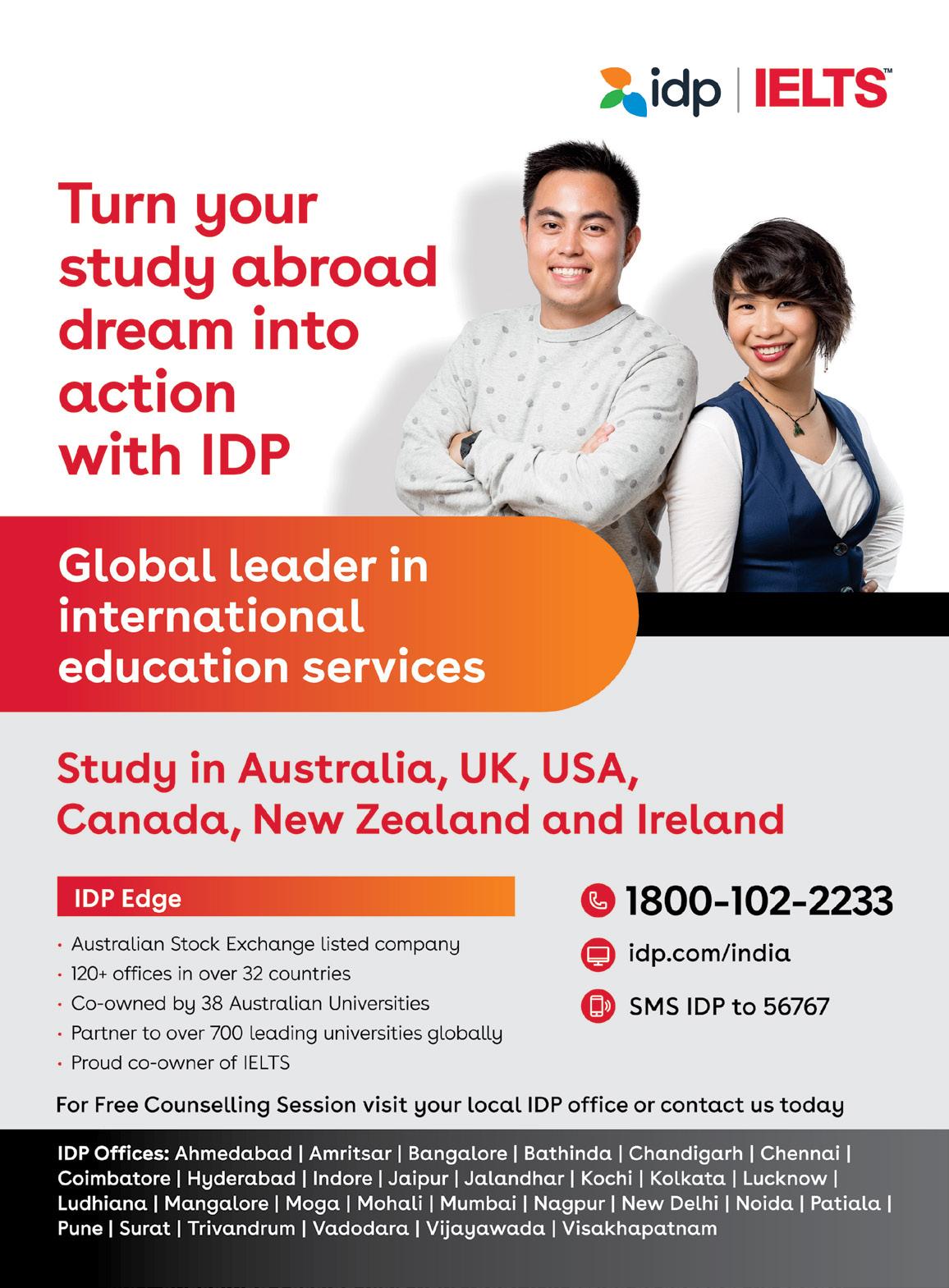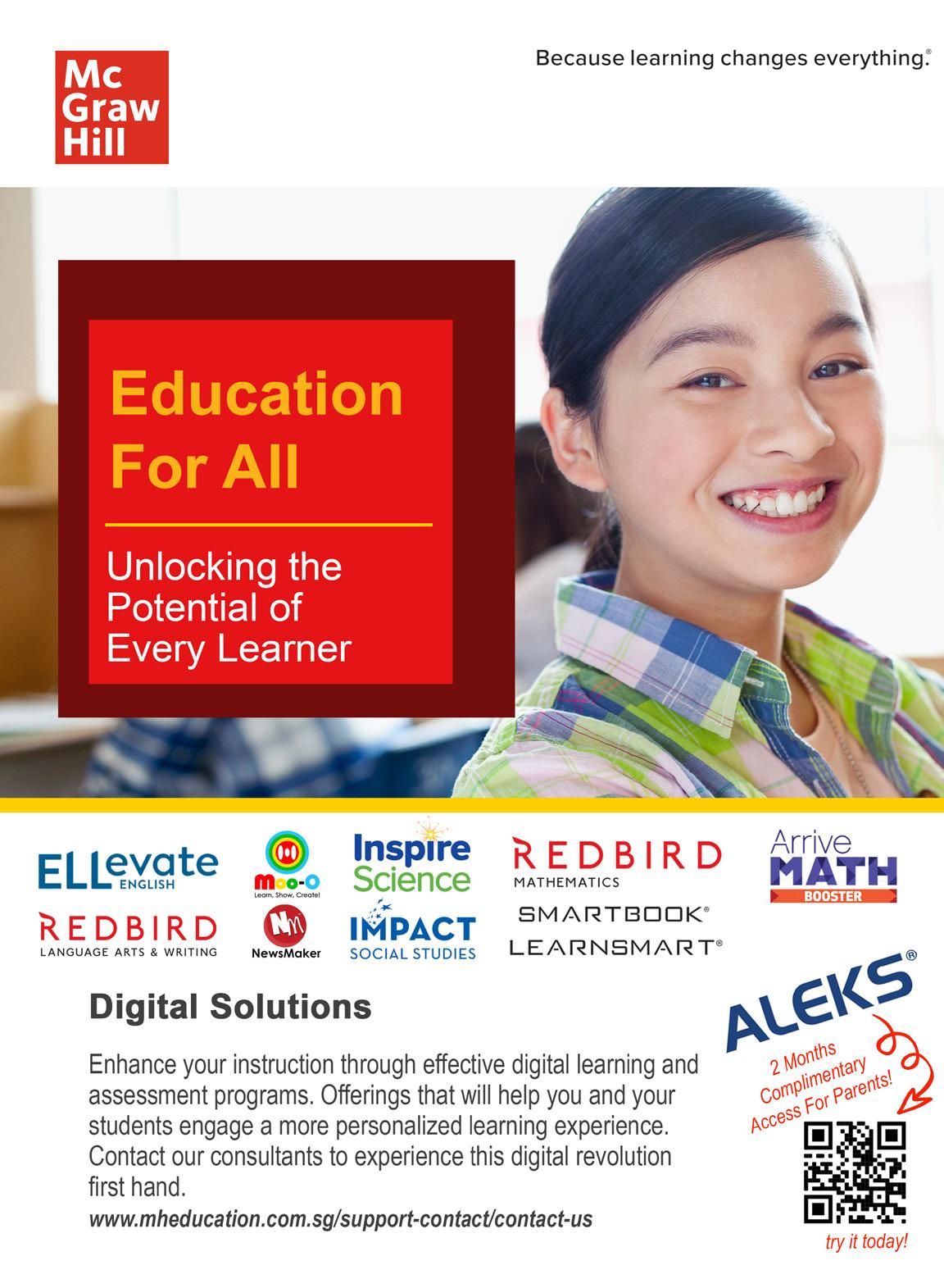



KALKA TO SHIMLA RAILWAY, INDIA istockphoto.com/shalender kumar

mustvisitdestinations.com
Best Practices in Education Special
Head of Advisory Board
Dr. Manoj Varghese, Ph.D
Managing Editor

Sarath Shyam
Consultant Editors
 Dr. Johny Andrews Komal Banchhor Joseph Alex
Dr. Johny Andrews Komal Banchhor Joseph Alex
Enquiry: admin@k12digest.com
Art and Design
Ajay K Das Manjunath R Rohith Poojary
Jennifer Anderson Rachel Roy Priyanka Pandewar
Sales & Marketing Enquiry: admin@k12digest.com

 Anuja Mulmule Roshni Rajagopal Emma James Monica Davis Anna Elza Reshma A
Anuja Mulmule Roshni Rajagopal Emma James Monica Davis Anna Elza Reshma A
GET THE MOBILE ISSUE


Subscription www.k12digest.com
International Representation



Americas
Connecta Global LLC 16192 Coastal Highway, Lewes, DE 19958, USA
Europe
Connecta Global Ltd. 27, Old Gloucester Street, London, WC1N 3AX, UK
Middle East
Focus Innovation Technologies FZE P.O. Box 48299, Dubai Silicon Oasis, Dubai, UAE
Asia-Pacific Connecta Innovation Pvt. Ltd. Ramanashree Arcade, 18 MG Road, Bangalore – 560001, India
K12 Digest is a digital magazine published by Connecta Innovation Private Limited. All rights reserved. The opinions expressed in the content and pictures provided are those of the authors. They do not purport to reflect the opinions or views of the Connecta Innovation Private Limited or any of its members and we do not assume any responsibility. The publisher does not assume any responsibility for the advertisements, its content, pictures, and all representation of warranties made in such advertisements are those of the advertisers and not of the publisher. K12 Digest is a Free Subscription digital magazine strictly not for sale and has to be strictly for internal private use only. Publisher does not assume any responsibility arising out of anyone printing copy of this digital magazine in any format and in any country and all matters related to that.




Digest September 20224 September 2022 Vol - 3 Issue - 9
The school education system that has not been subjected to periodic revisions is going through an adjustment period right now. In the wake of a global pandemic, preparing for the unknown was not an easy task for schools in India. However, they once again proved they could absorb the pressure and adapt to the required changes. Today, modern education methodologies like blended learning, online classes, experiential learning, and more have transformed the Indian education landscape forever.
Online learning tools indeed emerged as a boon when educational institutions could not keep their doors open. The result was skyrocketing EdTech industry that attracted massive investment from all over the world. We saw Indian EdTech companies joining unicorns and deacons clubs and competing with global tech firms. Keeping the business aside, what was the impact of online learning on students?
What Needs to Be Changed?

A survey on school education found that 60 per cent of the students who have recently shifted into an online learning system thought of the experience as boring and struggled with motivating themselves to pay attention in class. It is not different in the higher education sector. In another survey, 77% of 800 college students prefer in-person class learning better than online. These statistics point to the fact that there is a need to understand the various shortcomings in the online education field to address them.
The efficacy of online education is one of many challenges that need to be addressed. In this issue, we have gathered opinions and insights from various quarters for the education system to take these discussions further. We hope our efforts to bring such diverse topics will help you keep up with the latest trends in the education sector. Enjoy reading.
 Sarath Shyam
Sarath Shyam
K12 Digest September 2022 5
MANAGING EDITOR’S NOTE
INTERNATIONAL ADVISORY BOARD
Former International School Principal, Former Group Project Director at a World Class Learning Group, Education Consultant - Wright Solutions, United Kingdom

Stephen Cox
Chief Education Officer, New Nordic School, Finland
Zeljana Radojicic Lukic
Exceptional Educator from Serbia, Founder of Association of the Best Teachers of the Former Yugoslavia, Founder of Magical Intercultural Friendship Network, Founder of Creative Magic - Children’s International Festival, Founder of Magic Village, Serbia
Assistant Professor in Education, Ph.D. Supervisor and Researcher, Thailand
Dr. Lilian Bacich

Senior Educationist, Author, Keynote Speaker, Co-founderTríade Educacional, Brazil


Servatius (Servee) Palmans
Former Director School Administration & Business Operations (Large Education Group), Chief Operating Officer - BBD Education, Netherlands & UAE
Chief of Digital Learning and Development, Norwalk Public Schools, Connecticut, United States

Senior Teacher‘Pashko Vasa’ school Shkodra, Exceptional Volunteer, Albania
Founder & CEO - Paths to Math Ltd, Former Mathematics Teacher and Principal, Global Teacher Prize Finalist, Finland




English and Literature teacher, Owner of “The Smart Teens Studio of English” in Belgorod, Russia

Dr. Varughese K.John, PhD

Former Program Director, MS in Management Program, GSATM - AU, Thailand & India

Founder & National President - ATAST, General director of IFEST² the international projects competition in Tunisia, General secretary of MILSET Africa, BRISECC member, Tunisia
 Chris Wright
Dr. Stuart Grant Colesky Liljana Luani
Asst. Prof. Dr. Poonsri Vate-U-Lan
Ralph Valenzisi
Maarit Rossi
Elena Shramkova
Principal, Rundle College, South Africa
Hatem Slimane
Chris Wright
Dr. Stuart Grant Colesky Liljana Luani
Asst. Prof. Dr. Poonsri Vate-U-Lan
Ralph Valenzisi
Maarit Rossi
Elena Shramkova
Principal, Rundle College, South Africa
Hatem Slimane
K12 Digest September 20226
Master Teacher, Researcher, Innovator, Trainer, Philippines
Global Teacher Prize Finalist 2019, 15 International Awards on STEM, STEM Instructor, Educator, Neuroscience Researcher, Trainer & Author, Greece
Innovative Educator of Online Classroom, Pungsaeng Middle School, South Korea

Former Vice President Security (Large Education Group), Former British Army Officer (Airborne Forces), Senior Advisor – Resilience and Crisis Management (Emerald Solutions Group), United Kingdom & UAE

Innovative English and ICT Teacher, Author, Japan

Deputy Head and Dean of Faculty, Dalton Academy, Beijing, China
Revolutionary English Educator, Globally Connected English Studio - Hanoi, Vietnam
Master Teacher, Speaker and Researcher, Philippines


Mr. Ngô Thành Nam


Technology Academy Manager, Microsoft Learning Consultant, Global Trainer, Vietnam

EdTech Specialist, Speaker and Teacher Trainer, Innovative ICT Educator, ICT learning multimedia developer, Indonesia
Fethy Letaief
Distinguished Senior EFL Teacher, ISA Coordinator with the British Council, Motivational Speaker, Tunisia



Juan Manuel Pico Co-founder & Managing Partner, Education Soul, Colombia


Dr. Manoj Varghese, Ph.D
Senior Director – Global Partnerships, Advisory & Consulting – Connecta® | Head of Advisory Board – Higher Education Digest® & K12 Digest® | Adjunct Faculty –Assumption University | Former CIO – Athena Education | Former Global Director Technology – GEMS Education
 Rania Lampou
Dr.
M. Alboruto
Kihyun Park
Dr. Leonilo Basas Capulso
Angus Duthie
Herwin Hamid
Ian Deakin Ha Nga
Hidekazu Shoto
Shady Elkassas Director of Innovation Al Ittihad National Private School-Al Ain, United Arab Emirates
Rania Lampou
Dr.
M. Alboruto
Kihyun Park
Dr. Leonilo Basas Capulso
Angus Duthie
Herwin Hamid
Ian Deakin Ha Nga
Hidekazu Shoto
Shady Elkassas Director of Innovation Al Ittihad National Private School-Al Ain, United Arab Emirates
Digest September 2022 7
Venus
MENTOR’S OPINION
CONTENTS
ADMIN PERSPECTIVE
BEST PRACTICES
FINANCIAL EDUCATIONA MUST FOR A CHILD FROM BEGINNING
26
EVOLUTION OF TEACHING
Nindiya Saket, Principal, Manav Rachna International School Noida


K12 Digest September 20228 Divya Jain, Founder and Director, TCO1
POSITIVE EDUCATION: A STEP TOWARDS OPTIMUM LEVEL OF WELLBEING IN THE CLASSROOMS
Dr. Karnica Vyas, Academic Coordinator, Symbiosis Schools Central Directorate

CONTENTS
12 12
26
22 22
CONTENTS
EMPATHY FOR EDUCATION
Vijay B, Math Facilitator, GT group of Institutions

THE ‘A’ IN TECH TO TEACH!
Deepika Venkatesh, Academic Program Manager, 21K School


ACADEMIC VIEW
EMERGING TECHNIQUES FOR TEACHER TRAINING TO BRIDGE THE SKILL GAP
Sushma Raturi, Member Secretary, Academic Council, Saamarthya Teachers Training Academy of Research (STTAR)
K12 Digest September 2022 9
18 18
50 50
46 46
CONTENTS
PLANNING TO STUDY OVERSEAS? FACTORS TO CONSIDER BEFORE APPLYING FOR A UNIVERSITY
Ajay Sharma, Founder and President, Abhinav Immigration Services Private Limited

CHOOSING THE RIGHT BOARD POST GRADE 10
Aashna Nasta Jagasia, Head of Undergraduate Services, OnCourse
TECH IN CHILDHOOD LEARNING MATTERS
Prerna Jhunjhunwala, Founder, Creative Galileo


TOP 5 MYTHS ABOUT STUDYING ABROAD BUSTED!
Rahul Subramaniam, Co-Founder and Managing Director, Athena Education

K12 Digest September 202210
CONTENTS INDUSTRY PERSPECTIVE
30 30
38 38 34
34 42
42
Amazing Opportunity for Teachers and School Leaders to enhance their knowledge through FREE Teachers Academy masterclasses from international education experts !!! For more details and registration www.teachersacademy.com



CONTENTS
MENTOR’S OPINION
Evolution of Teaching
Nindiya Saket, Principal, Manav Rachna International School Noida
NindiyaSaketisthePrincipalatManavRachnaInternationalSchoolNoida.Sheisanexperienced principalwithademonstratedhistoryofworkingintheeducationmanagementindustry.Herareas ofexpertiseincludeeducationalleadership,strategicplanning,research,English,MSapplications. SheisalsoaBritishCouncilExpertforschoolteachers,studentsandleadersforCoreskillsprogram andteaching21stcenturyskills.Shepossessesstronginter-personalandleadershipskills.Astrong believerof‘BetheChange’,sheisalsoablogger,motivationalspeaker,atrainer,anavidreader, andapassionateeducationist.

K12 Digest September 202212
“E
ducation is not learning of facts but training of the mind how to think.” Albert Einstein Education has shown paradigm shift over a period of time. The system has evolved drastically in last few years. From the days of Gurukuls to the modern technological driven self-study, we have seen enormous changes. And every entity related to education in some form or other has seen changes. These changes are pedagogical and more inherently linked with the whole ideology of education. We have shifted from teacher centric to child centric, from knowledge based to holistic, from text based to whole explosion of information and so on and so forth. Teacher is no more imparting knowledge; teacher is a facilitator, mentor and motivator. Objectives have changed and so has the roles.
While much has been said about pedagogy, child centric learning and teacher as a facilitator, the inclusion of technology and tools still dwells on grey lines. Today I would try to bring about some kind of understanding to this aspect.
The use of electronic social networks (ESN) as a new teaching method that is chosen by modern teachers, who have sufficient professional, information, and communication competence, passed several stages of formation, and nowadays are widely used in the educational process in secondary schools.
Today technology serves as a useful tool in enhancing teaching skills and learning ability. Audio-visual education can be easily provided with the help of technology. Computers are a useful tool in all areas of teaching-learning. Multi-media technologies are used in schools, and colleges to communicate ideas between
By using modern technological devices teachers can expand their knowledge and develop their professional teaching skills
K12 Digest September 2022 13
students and teachers. Today technology-based education is attainable at the universities of developed countries. Smart schools have made a leap in virtual learning. Online learning and remote training are among new education forms in the new century. By evolving the learning environments at the beginning of the 21st century, individuals and societies put a heavy responsibility on the shoulder of educational institutions and their traditional structures by their increasing need for education.
The evolution of teaching and learning through technology integration is apparent at all levels of education. Technology and education have been brought together, which has changed the classroom as well as the
roles of the teachers and students. No longer is the classroom limited to four walls with a teacher using the conventional method. The roles of teachers and students are not the only roles to change. The choice of learning methods depends on the objectives and content of the educational material of each lesson; characteristics of relevant scientific field methodology, characteristics of specific teaching methods of an academic discipline; time spent on the study of a material; age peculiarities of students; their skills; equipment and material procurement of educational process, including equipment and others.
There are various benefits provided by the evolution of teaching techniques. Some of
The use of electronic social networks (ESN) as a new teaching method that is chosen by modern teachers, who have sufficient professional, information, and communication competence, passed several stages of formation, and nowadays are widely used in the educational process in secondary schools
K12 Digest September 202214
these are included below. The vast array of educational technology that is available today offers students a wide range of options from which they can choose the best ones for their learning needs. This helps them develop the right kind of skills and knowledge so that they can become good professionals in their chosen field. This, in turn, offers a wider choice of materials that can be accessed easily.
It also helps improve learners’ communication skills and performance in school and workplace settings because learners who are able to communicate better through technological means will also perform better academically as well as in work settings because communication skills are very important when you want to get your point across effectively.

In today’s world, it is essential for students to be able to access the internet from anywhere at any time so that they can do their assignments and research without having to travel all over
a place or wait for a particular time when they can do so.
Using educational technology helps learners in this regard because it allows them to connect with the internet even when they are in a classroom, at school, or at home. The use of teaching technology also is advantageous for teachers. Technology facilitates sharing of resources, expertise, and advice. It ensures greater flexibility for teachers for carrying out different kinds of tasks at different times. It promotes the skills, confidence, and enthusiasm of teachers through various teaching techniques. It helps teachers in easier planning, preparation of lessons, and designing of teaching-learning materials. Through graphics, pictures and PPT teachers can present the material in more interesting and attractive ways. A teacher can guide and help students in searching for qualitative material. Students learn through interactive
K12 Digest September 2022 15
technologies and the teacher facilitates them on how to use and reflect responses. The teacher may be diagnosing learning problems and helps the students in finding the solutions. By using modern technological devices teachers can expand their knowledge and develop their professional teaching skills.
Since every coin has 2 sides, the evolution of teaching technological techniques also has its own disadvantages. Results in lack of interest in studying-As everything is now accessible or through data saved in a computer or mobile devices. It develops poor study habits and a lazy attitude among students through education. Nowadays students are more dependent on the internet instead of their books and input from teachers. Students might discover unusual things on the computer-The Internet does not always help students in search of things that are valuable for them. There are several things found on the internet that are not good for students. As a result, students may take the wrong path. Also, it hinders academic performance. Instead of using their laptops and tablets for their studies and online tests, students more often visit social networking sites which may lower their academic performance. It is Expensive as IT facilities are not available in the schools. Most of the schools are not in a position to afford the purchase, maintenance, and other expenditure involved in its use. The cost of laptops, and wireless broadband projectors for example contributes a large percentage of the school budget. There is widespread ignorance about the use, applications and advantages of IT on the part of teachers, head of the institution and educational authorities
responsible for bringing improvement in the functioning of the school particularly related to teaching learning and organization of co-curricular activities with the help of such technologies.
Today’s teachers are not well-equipped with the modern use of technology. There is a greater paucity of such competent and skilled teachers who can use and integrate the right technology in an appropriate manner for effective integration of IT in dealing with school curriculum bringing desired change in the behaviour of the learners. The prescribed curriculum in schools, colleges and university, the examination and evaluation system, the available instructional material and the infrastructure is not in a position to provide desirable support for the use and application of IT in the teaching-learning process and other useful activities for the benefit of the pupil. Lastly, it can be said that lessons delivered online or through digital resources reduce the face-toface interaction between teacher and student that provides a more personal experience.
In a nutshell, Education technology is a systematic and organized process of applying modern technology to improve the quality of the educational system. This paper introduced advances in educational technology, history of use of technology teaching and learning process. There are various types of the technologies currently used like radio, television, audio tapes, video tapes, projector, computer and internet in teaching and learning process. Educational technology has impacted both students and teachers in the learning and teaching process respectively. Lastly, introduced the major disadvantages of technology in the learning and teaching process.
K12 Digest September 202216










Continue Learning with A Secure Virtual Classroom for K-12 Share files and applications Poll students Interact with breakout groups Chat with fellow participants The raise hand feature ensures every student has a voice Use in the classroom and beyond JOIN SESSION Easy login, no downloading or installation Share and record video and audio Create personalized profiles
The ‘A’ in Tech to TeAch!
Deepika Venkatesh, Academic Program Manager, 21K School

Deepika is currently working as an Academic Program Manager at 21K School. She switched careers from being a Senior Risk and Regulatory Affairs Analyst at Deloitte to the field of education as a senior school educator with an aim to magnify sustainable education. Being a digitally certified educatorbyorganizationslikeNationalGeographic,UNESCO MGIEP,Googleandmanymoreshebelievesinencompassing progressive teaching and learning techniques in classrooms foraqualityeducation.

K12 Digest September 202218
ACADEMIC VIEW
Off late, we have been experiencing a massive traffic in the professional world due to rapid changes in the economy. One of the results is a surge in demand for various skills in tech, logical reasoning, communication and many more. These changes have caused education to rethink the ways to educate young minds taking into consideration the new era of career development.
Especially, when we talk about technology, it has entered every nook and corner of our lives. From paying for vegetables to switching off your air conditioner requires usage of technology. Well, the quicker we adapt to the changes the easier it gets us going in terms
of this competitive world. Where does it all start from?
Education. It all starts from schools and colleges. Core responsibility of educators is to provide knowledge and train students based on present requirements. Technology has changed the nature of education and careers of educators. 21st century learning is demanding for 21st century teaching as well.
How can we bring the tech into teaching? If you are an educator, get yourself equipped with digital skills and tools: Before we teach, we learn. There are multiple tools and courses on the web, which gives us access to digital education. Many of them are
Technology has changed the nature of education and careers of educators. 21st century learning is demanding for 21st century teaching as well
K12 Digest September 2022 19
for free too. Invest some of your time learning how to teach online and how to become a digital teacher with these courses. They help you to understand the importance of learning with technology and be on par with the changes. Some of the platforms that provide opportunities to learn technology in education and worth spending time include but are not restricted to are:
1. UNESCO MGIEP The Digital Teacher Course
2. LinkedIn Learning
3. National Geographic Certified Educator
4. The Apple Teacher
5. The Google Certified Educator
6. Coursera
Create your own teaching materials: Before entering your classroom, invest some of your time in homework! When I am saying homework, it doesn’t mean you will have to sit and write down questions and answers, it means to do what needs to be done and why it needs to be done. Sit for sometime and make your own notes of different mindsets and their learning skills. Based on learning outcomes of a particular topic, create your own teaching material which includes digital techniques to grasp students’ attention and interest. Some of the tools can include but are not restricted to are:
1. Padlet- For a session feedback and topic discussions.
Before entering your classroom, invest some of your time in homework! When I am saying homework, it doesn’t mean you will have to sit and write down questions and answers, it means to do what needs to be done and why it needs to be done
K12 Digest September 202220
2. Audacity- To create interesting audio files
3. Kahoot- To create interactive questionnaires, discussions, or surveys that complement academic lessons.
4. Animoto- To create high quality videos from any mobile device to make lessons more fun and interesting.
5. TED-Ed- To get easy access to information. Understanding concepts is made visually appealing with TED-Ed.
6. Quizlet- For flashcards and fun activities to remember the concepts and technical terms
7. Canva- To create infographics and creatives for presentations
8. Coggle- A mind mapping tool to encourage thinking
9. Mentimeter- Allows students to vote for any question posted by a teacher which makes the classroom more responsive.
10. Wordle- Generates word clouds that help students to learn and understand words in a playful manner.
Dedicate a session to imbibe digital literacy into the subject:
Digital literacy is an important element while dealing and developing with technology. Usage of technology also emphasizes learning how efficiently and effectively we can do it. Once in a while teach students the importance of finding, evaluating and communicating information through typing and various other media platforms. It is more about how well we use the right information and create accessible
information for everyone everywhere. Getting digital literacy into the walls of education will make students future ready. It is always an add on to traditional education.
Include virtual activities into the mode of learning:
We do include a lot of fun activities in our classrooms however what about virtual activities. Virtual activities build a different perspective in understanding a curriculum and subjects. Something different is always a plus in teaching. Try to build virtual activities and virtual games which can ignite the child’s ability to learn better. Conduct 3D Cybermuseum competitions, play online scavenger hunts, Minecraft: Education Edition, Werewolf, virtual field trips and many more.
Conclusion:
Remote learning was an emergency during the pandemic, however, it is the new norm. Tech is taking a new shape in every field and this can be well taken care of starting from the field of education. All classrooms must be furnished with technology walls of learning to make students’ learning holistic and comprehensive. This is perhaps the updated version of educating to meet the present and future needs. The Metaverse era is now here and we are all in it. Let us together make a better tomorrow for our young minds and make a sustainable living through the right education. Happy teaching and learning.
K12 Digest September 2022 21
ADMIN PERSPECTIVE
Financial EducationA Must for a Child from Beginning
Divya Jain, Founder and Director, TCO1
Financial Education is one of the most fundamental and underrated aspects of an empowering career and holistic personality growth. It refers to a set of skills mastered by a person with adequate knowledge of various elements of finances, such as personal financial management, budgeting, and investing.
The application of financial education is equally important. Monetary wealth and resources cannot be efficiently managed in the absence of financial literacy. That is why it is essential for students to have a resourceful knowledge in finance academics so
K12 Digest September 202222
Divya Jain, a commerce graduate from the Delhi University is presently running two schools in Noida successfully. She is full of ideologies, enthusiasm, in-depth knowledge and intellect. A woman of few words who lets her work ethics and professional discipline speak on her behalf. She is well known for her integrity, humility and matured sense of discretion coupled with strokes of motivation and confidence. She is assiduous in whatever she does and her commitment to good governance, people management was honoured with “Design Thinking Leaders Award” by Education World Grand Jury.

Financially literate individuals prove to be sound decision-makers. They possess rational cogitative abilities and are independent thinkers
K12 Digest September 2022 23
If students are well-educated in the realm of monetary finances and resource management, they are better able to assess investment worth, deals, and products and discern which ones are valuable and which ones are not

K12 Digest September 202224
that it can be practically implemented while managing finances and regulating cash flows. The mention of financial academics in no way means to go through the litany of economics concepts and esoteric finance-specific studies. It denotes gauging an overview of mathematical metrics and financial prudence, which enables a person to manage their finances in an efficacious manner. As a result, frugal investments replace slipshod money management.
Although, the rate of financial literacy in India is a matter of concern. As per the SEBI report, only 27% of Indians are financially literate. It was a disquieting revelation and showed the need to reprogram policies and emphasise financial education among students, especially in Tier 1 and Tier 2 cities. Financially literate individuals prove to be sound decision-makers. They possess rational cogitative abilities and are independent thinkers. There are fewer chances for them to be susceptible to financial fraud, and they do not even need to rely on other sources or think tanks to taking decisions.
A recent policy decision has thrown light on the institutional proactiveness of responding to the changing scenarios. The Central Board of Secondary Education (CBSE) has introduced a short-duration module related to Financial Literacy for classes VI, VII and VIII. It has also outlined a sensitisation programme on Financial Literacy for all the teachers. The decision comes off a fresh change to tackle the facile state of financial literacy in the Indian education spectrum.
Another reason why students should be financially literate is because of the
expansion of the market hegemony and the availability of a range of options. Students are young, docile and have impressionable minds, so it is easy for them to buy things they do not need and can waste their money on multiple channels of engagement. It can lead to shambolic money management and gross dissipation of financial resources.
The need for financial education is more prominent after the Covid-19 pandemic. The economic conditions of several families were in the doldrums. Many youngsters were jobless without sufficient savings. Clearly, there was a stark lack of financial planning observed among Indians. It highlights the urgency to plan out and initiate proper financial literacy subjects and programmes.
Students can turn out to be better and more efficient financial managers and allocate assets in a self-aware way. Financial Awareness is an end product of financial education. If students are well-educated in the realm of monetary finances and resource management, they are better able to assess investment worth, deals, and products and discern which ones are valuable and which ones are not. It is also helpful for them on a day-to-day basis as they will carefully manage their finances, make an expenditure list, and saving planner, and execute things in an organised and well-planned manner.
Financial education should not be an optional study paper, but compulsory rigorous learning for students to be financially sagacious and compatible and use cash and money outflows astutely.
K12 Digest September 2022 25
BEST PRACTICES
Positive Education: A Step Towards Optimum Level of Wellbeing in the Classrooms
Dr. Karnica Vyas, Academic Coordinator, Symbiosis Schools Central Directorate
Dr. Karnica Vyas, pursued her doctoral research on the topic of ‘Brain-based learning’ i.e. how and in what condition our human brain learns best. She is currently working as an Academic Coordinator in Symbiosis Schools CentralDirectorate,Symbiosis,Pune,lookingafter thequalitativeacademicupliftmentof7Symbiosis schools, catering to different educational boards across Maharashtra. As a passionate teacher educatorandenthusiasticresearcher,shealways strives hardest to make the classroom a joyful place of teaching and learning. For the same, so far, she has imparted dozens of trainings and workshops for the teachers as well as students on different pedagogical methods and learning strategies to make learning a meaningful and purposefulbusiness.

K12 Digest September 202226
Last few years served as an excellent recipe for bringing the transformation in education. On one hand, pandemic acted as a blessing in disguise and has completely overhauled the contemporary education system and practices. While on the other hand, NEP 2020 is strongly advocating the student centric educational reforms. Amongst all of it, one common ingredient throughout is the wish and hope for the children of the Nation to be happy, to flourish and to realise their true potential. Apart from all other latest pedagogical reformations and technological interventions, extending a positive learning experience is the heart of anything you do in the classroom. However, it can only be created when pedagogical practices are targeted towards the development of
positive cognition, positive emotions and giving overall positive experiences.
Now the major question arises how exactly positive learning in a classroom looks like or how positive education can be extended in the schools. Martin Seligman (2000) from University of Pennsylvania, propounded Positive psychology and its amalgamation into education in order to create a positive learning environment in the classroom is being noteworthy. Following are the major elements which are found to be critical for imparting Positive education in the classrooms.
Positive Emotions: A classroom should be an epicentre of positive emotions. Any teaching and learning methodology implied in the classroom should gravitates towards creating the emotion of joy, gratitude, curiosity, interest, hope,
Celebrating accomplishments is extremely essential in the growth of a child. This helps in not only building up positive self-esteem, but also motivates them to continue working towards their goals
K12 Digest September 2022 27
amusement, inspiration, pride etc. Creating positive emotion in the classroom are important because it helps in developing a physically and emotionally safe environment for children by decreasing the stress hormone cortisol and increasing feel good chemical messengers in the brain such as dopamine and serotonin. Human brain is wired in a way that it is receptive to new learning only after the brain receives the message of feeling safe and secure. Therefore, teachers should emphasize on boosting positive learning experience by knowing and connecting with students’ interests, greeting every student, helping students developing a growth mind set by stating your clear expectations, talking about your growth oriented belief system, using humour while teaching, asking students to journal down every day’s learning, focusing on small things which can uplift the mood, for e.g. singing songs or conducting ice breaking, cross lateral exercises can help in developing positive emotions in the classroom.
Engagement: Teaching and learning in a classroom should always be emphasized in a way that it can extend an absolutely engaging environment where students are fully absorbed in doing such activities which challenge them and at the same time utilise their potential to its maximum. Apart from hands-on-activities even a good and thoughtfully asked questions can also lead to a fruitful engagement in the classroom. Now when I say good question, then what does it mean? A good question cannot be answered just by a Yes-No response, a question is considered to be good, when it can arise the curiosity or can lead the children to think laterally, introducing the topic with ‘I wonder’ questions or prompting students to craft their own ‘I wonder’ questions. Such strategies may not only improve students’ engagement but also helps in building up scientific temper.
Any teaching and learning methodology implied in the classroom should gravitates towards creating the emotion of joy, gratitude, curiosity, interest, hope, amusement, inspiration, pride etc
K12 Digest September 202228
Positive Relationship: For developing the positive learning experiences in the classroom, it is really important to build positive relationship between teacher and students and amongst peers too. Positive relationships are the foundation for learning success. Yet this part is generally neglected by teachers to take the time to learn about their students as an individual. In the absence of positive relationships in the classrooms it can create barrier to learning and can make even small interactions challenging to handle. There can be various ways to develop positive relationship in the classroom for e.g. finding small ways to connect with students or allowing students themselves to connect with each other, focusing on the respective strengths, sharing admiration and appreciation, sharing your own struggle and how you cope up the situation, going on excursions, camps and involving in other group activities. Simply listening can also act as the best way of winning the trust of the children and develops positive relationship. This is important as it helps not only in motivating the children but also correcting the students’ behaviour.
Extending Meaning/Purpose: As per Neuroscience, the human brain receiving tons of information every day from all around, can store only that information in its long term memory which makes meaning and sense to it or gives a purpose to go ahead. Rest of the information which doesn’t make any meaning stores only in the short term memory and drops out of the system after a while. Teacher should focus on such pedagogies which can help in extending the meaning or purpose to whatever has been taught. For e.g. Involving children in Project based learning, cooperative learning, involving
children in various skills based courses, organizing competitions at different levels, giving opportunity to participate in various community events etc. All such initiatives can help in extending the meaning to whatever has been taught and gives a sense of purpose to education.
Accomplishment: Facing challenges and obstacles are important part of a child’s growth and development. When the children face challenges and overcome them with victory irrespective of how big or small is the success. Celebrating accomplishments is extremely essential in the growth of a child. This helps in not only building up positive self-esteem, but also motivates them to continue working towards their goals. Teachers should celebrate the little or big accomplishments of children by rewarding them in the most appropriate way, displaying their achievements, sharing achievements with fellow teachers in the school or friends and family.
There is a vast difference between schooling and education, where the former enables an opportunity for children to realise their full potential and ability, however the later one enable people to live well in a world worth living. Positive education uses science of positive psychology in schools. Positive education allows students to imbibe the qualitative aspects of growth mindset and capitalising on their strengths rather than weaknesses, which ultimately leads to develop an optimum level of well-being. Any education which can extends the opportunity of knowing and understanding your own self, feeling and doing good, helping others, participating constructively towards society, all together can create a powerful education experience, which is a dire need of the hour.
K12 Digest September 2022 29
INDUSTRY PERSPECTIVE
Choosing the Right Board Post Grade 10
Aashna Nasta Jagasia, Head of Undergraduate Services, OnCourse
Aashna completed the IB Diploma at Dhirubhai Ambani International School and then pursued her BBA at Singapore ManagementUniversitywhereshegraduatedMagnaCumLaude,doublemajoring in Marketing and Corporate Communication. At OnCourse, Aashna is the Head of Undergraduate Services. She also co-founded OnCourse’s test prep division, UPrep, and headed the company’s business development in the Middle East. In her free time, she can be found reading fiction, writing poetry, experimenting with new recipes and traveling.

K12 Digest September 202230
Before we delve into this topic, let me clarify one thing - there is no such thing as the ‘best board’ or the ‘ideal board’. What matters is which is the right board for YOU! This is based on a lot of factors - your learning style, your current board, subjects you like and your career plans.
Students often get swayed by what their friends are doing or what their parents hear from other parents. The first step to pick the right board is to gain knowledge about all the available boards. Here is a summary of the popular boards available in India:
CBSE/ISC/HSC
Type: Indian Boards
Available Streams: Choose between Humanities, Commerce & Science
Subject Options:
Humanities Stream - English, Second Language,
Economics, Political Science, Psychology, History, Sociology, Art
Commerce Stream - English, Second Language, Accounts, Organization of Commerce, Business Studies, Econ, Math and Secretarial Practice
Science Stream - English, Second Language, Physics, Chemistry, Math, Biology, Computer Science, Electronics
Points to Note:
In ISC, second language is not a requirement
All 3 boards allow you to pick Math with the 3 streams
ISC and CBSE boards are more flexible than HSC and allow you to take subjects across streams
Grading Scale: 0-100
International Baccalaureate
Type: European Board
Subject Groups: First Language, Foreign
Students often get swayed by what their friends are doing or what their parents hear from other parents. The first step to pick the right board is to gain knowledge about all the available boards
K12 Digest September 2022 31
Students studying the American curriculum take AP exams in place of traditional board exams, however, students pursuing other boards also have the option of taking AP subject tests in subjects of their choice to boost academic rigour
Language, Social Science, Science, Math, The Arts
Subject Options:
First Language: English Language & Literature, English Literature & Performance, English Literature
Foreign Language: Hindi, French, Spanish
Social Science: Economics, Business Management, History, Geography, Psychology, Global Politics
Science: Physics, Chemistry, Biology, Computer Science, Environmental Sciences
Math: Mathematics Analysis and Approaches, Mathematics Applications and Interpretations
The Arts: Visual Arts, Theatre, Music
How do you pick the subjects?
You pick a total of 6 subjects, one each from Groups 1 to 5 and 1 from Group 6 or another Science/Social Science. Of these 6 subjects, choose 3 subjects at a higher level and 3 subjects at a standard level.
Additional Requirements: In addition to these 6 subjects, you must complete an Extended Essay (in any subject), Theory of Knowledge and CAS (Creativity, Action and Service)
Grading Scale: 1-7 A Levels
Type: British Curriculum
Popular Subjects: English Language, Chemistry, Physics, Biology, Mathematics, Accounting, Psychology, Economics, Accounting, Business, Geography, Computer Science, IT, Global Perspectives, History, Mathematics (Note: Subjects offered differ from school to school. This list only lists the popular subjects)
K12 Digest September 202232
How do you pick the subjects?
A Levels don’t have streams or subject groups, you can choose 3-5 subjects of your choice based on your career interests. In India, most schools require you to take English + 3 additional subjects.
Grading Scale: A* -E
Advanced Placement (APs)
Type: American Curriculum
Popular Subjects: English, US History, Government, Biology, Chemistry, Physics, Calculus, Statistics, Microeconomics, Macroeconomics, Human Geography, Psychology
Grading Scale: 1-5
Taking AP tests along with other boards:
Students studying the American curriculum take AP exams in place of traditional board exams, however, students pursuing other boards also have the option of taking AP subject tests in subjects of their choice to boost academic rigour. Students can take these tests between Grades 9 and 12.
Now that you’ve understood each of the boards, speak to your seniors from different boards and ask about their experiences.
Next, shortlist the boards and make your own pro and con list.
Ask yourself the following questions:
Am I leaning towards studying in India or going abroad post Grade 12?
Do I have multiple academic interests or am I focussed in a particular subject
Can I handle the rigours of the IB?
If I’m doing well in my current board, should I rock the boat and switch to another board?
To help you make the right choice, here are some myth-busters:
Myth: If you want to apply to the US for your undergraduate education, you must study the IB.
Fact: You can apply to the US for your undergraduate education with any educational board.
Myth: Take the A-Levels only if you want to pursue your undergraduate education in the UK
Fact: The A Levels are accepted by all countries across the world.
Myth: If you study IB or A Levels, you can’t pursue your undergraduate education in India

Fact: You can pursue your undergraduate education in India even after studying the IB/ALevel in grades 11 & 12.
Myth: You can only take Advanced Placement subjects if you’re studying in an American school.
Fact: Advanced Placements are open to all students through the College Board.
Essentially, make the right choice for YOU after weighing in all these factors!
K12 Digest September 2022 33
Planning to Study Overseas? Factors to Consider before applying for a University
Ajay Sharma, Founder and President, Abhinav Immigration Services Private Limited
Ajay Sharma is a Business Economist (Masters, Batch of 1985, Delhi University) and Commerce Honours graduate (Batch of 1983, Delhi University). He is a serial entrepreneur. He is amongst the pioneers of immigration and visa consultancy services in India since 1994. His strengths include Consultancy and advisory services on Citizenship by investment programs, Start-up Visa Programs, Residency visa programsforskilledprofessionals,Businessmen,andHighnetworthindividuals.AGlobeTrotter and an affluent speaker, he is an all-cross-culture expert. He is a featured author in publications like Economic Times and is often quoted in Global Mobility, Immigration, Jobs Overseas.

K12 Digest September 202234
INDUSTRY PERSPECTIVE
Indian students are increasingly opting to study abroad for higher education. Undoubtedly, studying overseas is the best future investment for a student hoping for a bright and fulfilling future. As of March 2022, 1 33,135 moved abroad for higher studies. As per the Ministry of External Affairs, in 2020 alone, 261,406 Indian students went to foreign universities. The Ministry also reported that the number could be enormous if the pandemic had not hit the world. In 2021, 71,769 Indians had moved abroad for study purposes. The vaccination drive and ease of Covid-19 restrictions worldwide made it easier for Indian students to plan their international education. Despite the risks, many Indian students expressed interest in studying abroad amid the pandemic. It indicates an increasing number of Indian students
are moving abroad for remarkable education opportunities, a better quality of life, promising job opportunities, etc. It is also observed that students now prefer a destination that offers a complete package like healthcare cover, student support, post-graduation work opportunities, and permanent settlement.
But, how does one decide which foreign university to choose while planning global education? While research, proper counseling, and planning are crucial, it’s clarity that students must chase. Get your notebook and jot down the following points we have prepared for you.
Program/Course Availability
Programs like humanities, business administration, science, or commerce courses are available in
While research, proper counseling, and planning are crucial, it’s clarity that students must chase
K12 Digest September 2022 35
almost every country and university. However, if you are planning to pursue a specialized course with limited university options, there are chances that it will not be available in your preferred country or university.
Before shortlisting the university, you must check whether the availability offers your desired program or not. It can be one of the most crucial factors in selecting a foreign university.
Know your reasons for studying abroad
Studying abroad is a different experience, so you must be well-prepared for it. Your decision should be your own and must be motivated by your professional goals. Don’t go for overseas education just because your best friend is there or your neighbor is studying in a particular college. Please don’t go to a country because of its PR facilities. Go for self-development, self-learning, and a competitive profile. Foreign education is a memorable experience; enjoy the journey. Keep PR or any other goals aside for a while. You will eventually get everything you desire with your hard work and dedication.
Cost of Education
Some courses are costlier but give higher returns upon completion. On the contrary, some programs are economical with less demand and a low
survival rate in the host country. Besides, some universities have higher tuition with a low living cost or vice versa. Student aspirants must consider the university and country factors before opting for a loan. You may also check for grants and scholarship options to determine your preferences.
Exposure to a new culture and lifestyle Studying in a foreign land is all about intercultural connection and socialization. So, a student must be prepared to adjust to new people. Ask yourself whether you are open to a new culture and language. Are you ready to connect with strangers? Can you change your eating/sleeping habits? Are you prepared to work part-time while managing your studies? If you are not ready for these, abort your mission immediately. As an international student, you will face many challenges; you must enhance your language skills to adapt to the new environment and culture.
University location
International students have a mindset to go to colleges in metropolitan areas. There is nothing wrong with choosing a famous university in the center of a big urban city. But this doesn’t mean colleges outside the city don’t have good scope. Choosing a college and suitable course in small, regional areas have equal networking opportunities and interactions with industries just like any big
Studying abroad is a different experience, so you must be well-prepared for it. Your decision should be your own and must be motivated by your professional goals
K12 Digest September 202236
city college. Fees are also comparatively cheaper. Countries such as Canada and Australia encourage students to opt for universities in small regional areas as they also have great opportunities for jobs and permanent settlement.
Also, prime locations in America, such as New York, California, Los Angeles, etc., are more expensive, whereas places such as Houston, Texas, and Atlanta may be more affordable. On the contrary, Canada and Ireland are cheap for international students, while Germany, Sweden, Norway, and Finland are famous for outstanding public universities.
On Campus Jobs/Internship/ Assistantships
Many foreign universities have facilities to work on-campus for international students. At the same time, some students prefer part-time jobs outside the campus. Both options allow students to build their professional network and gain valuable
experience. On-Campus jobs and assistantships are an excellent way to earn extra money while taking classes. Moreover, you save time and money as you don’t have to travel outside the campus.
Employment Opportunities
One must research possible job opportunities for your chosen study program. You must learn about the post-work job opportunities and whether your course is in-demand in that country. Relevant job opportunities are required while applying for a study visa as authorities want to know why you wish to study there. Anyone who wants to study abroad must have clear goals and knowledge of the job opportunities available, especially when they have immigration plans. When you select the course and country, ensure that the skills you will gain are valuable to prospective employers in that country.
Immigration and Visa Rules

Knowing the immigration rules of your desired country is essential before choosing it for your educational pursuits. It becomes even more critical if you have plans to stay back and permanently settle in that country. Student visa aspirants must learn about post-study visa norms, stay-back options, and work visa guidelines. Countries like Canada and Australia have stay-back options for international students, while the U.S. has stringent rules. It’s worth noting that visa rules change with the change of government. So, ensure you keep a tab on the government policies regarding visas in that country.
Studying abroad is a life-changing decision, so do your best research before jumping to conclusions. Considering the points mentioned above to avoid mistakes and confusion.
K12 Digest September 2022 37
Tech in Childhood Learning Matters
Prerna Jhunjhunwala, Founder, Creative Galileo
PrernaJhunjhunwalaistheFounderofCreativeGalileo, Little Singham- Kids Early learning app. Prerna is committed to delivering innovative pedagogy and has a vision to modernize and upscale the education imparted to children in their budding or formative years. She is a firm believer that a child’s future not only depends on the grades in various subjects but also on their impeccable social, cognitive and leadership skills. She is also the founder of Little Paddington, a chain of highly acclaimed schools in Singapore established in 2015. Prerna holds a Bachelor’s degree in Science from The Stern School of Business, New York University and has nearly a decade’s experience in the field of education.

K12 Digest September 202238
INDUSTRY PERSPECTIVE
In an increasingly digitized world, the role of technology in learning starts at an early age When we talk about childhood learning and development, there’s a Chinese proverb that comes to my mind. It goes like this “Do not confine your children to your own learning, for they were born in another time.” Never before would this proverb have held greater significance than now when the pandemic has confined children to homes and learning is increasingly getting routed through technology. While the role of technology in education now goes hand-in-hand, what often goes unnoticed is how beneficial technology is in the early stages of childhood. The perils of too much dependency on technology, be it for any group, has been spoken about ad nauseum. But technology, when used appropriately, can
go a long way in shaping young minds. Since the development of touch screens, the use of technology in early childhood development has been further accepted as children as young as four are able to navigate through it effortlessly.
Here’s a lowdown on the four development categories that needs attention in the early years and how they can gain significantly through the aid of digital tools:
Physical Development: The development of fine motor skills is one of the foremost aspects of early childhood. It is fine motor skills that help a child learn how to use the smaller muscles of hands, like how to hold a pencil or even play with blocks. Children are attracted by bright colours and moving images, to chase them on screen they will figure out how to navigate through various options on the screen. Using the
Cognitive or thinking skills are developed effectively when a child tries to make sense of images on the screen
K12 Digest September 2022 39
mouse of a computer or even navigating through the virtual keypad on an i-pad allows this skill to be enhanced. Be it allowing a child to complete a picture on the computer or make them trace alphabets that they see on the screen to a paper, these are ways in which tech helps take the baby steps towards early learning. Tapping, scrolling, swiping has become a child’s play, one that unintentionally allows learning.
Cognitive Development: Often screen time is looked at as a negative impact tool without us recognizing how it aids cognitive development. Cognitive or thinking skills are developed effectively when a child tries to make sense of images on the screen. Through games, children pick up cues in developing nonverbal communication, an important aspect of enhancing cognitive skills. They are more likely to be engaged without getting bored when they pick up cues from screen through bright imagery.
Linguistic Development: Today classroom pedagogy has taken a new shape where every child is learning using a device. At a time when learning has shifted online for most children, linguistic skills are honed at a faster pace. Bilingualism has become the order of the day. Several apps help children pick up multilingual skills as audio-video visuals leave a deep impact. Infact studies have shown that early learning of languages increase brain’s attention process towards solving problems or performing a variety of mentally demanding tasks at a later stage.
Socio-emotional Growth: This is a necessary soft skill that allows children to collaborate effectively with their peers, parents and educators. So can tech enhance a child’s social skills or emotional behavior? Yes, it can. When
a child is engaged in a game, he or she picks up key lessons in collaboration, teamwork and communication. Early influences help shape emotional bonding, say for instance, an educator or parent can engage with the child and find out what kind of an emotion he or she felt after watching a cartoon. A reward point in an app is a useful tool that teaches children a valuable lesson in reflecting on behaviour.
As is evident from the above pointers, making screen time constructive is the need of the hour. As children cross the threshold of primary schooling, they navigate the tech world much on their own. But the role of technology at a younger age has to be shaped with help—one that focuses on intellectual and behavioural skills. The key is to identify the age-appropriate tech tools, present them in a non-linear fashion to children and allow them to have a fun time with the smorgasbord of learning apps at hand.

K12 Digest September 202240
 INDUSTRY PERSPECTIVE
INDUSTRY PERSPECTIVE
Top 5 Myths about Studying Abroad BUSTED!
Rahul Subramaniam, Co-Founder and Managing Director, Athena Education
RahulisaneducationcoachandaStart-upco-founder devoted to building creative organizations that impact and uplift societies. His primary venture, Athena Education, helps students become the best versions of themselves and receive admission to top universities around the world. Rahul went to high school in Fremont, California. He received perfect SAT scores and got into every Ivy-League college he applied to, finally choosing Princeton over Harvard. At Princeton, he studied Politics with a certificate in Political Economy. Post his graduation, Rahul served as a Director of College Counselling at a prestigious college counseling and test prep company in California.

K12 Digest September 202242
Let’s face it: the prospect of studying abroad can be both inspiring and intimidating. The road from initially considering a program to actually setting foot on a campus halfway around the world may seem lengthy and full of dead ends. To top it all off, there is an abundance of inaccurate information at every turn, taking the form of rumors and misconceived notions. One cannot afford to leave such a life-changing decision to be guided by a faulty compass.
Together, let’s attempt to bust the myths and establish a map to match the territory.
Myth 1: It’s inaccessible to most social strata
Almost a decade back, the study abroad option was realistic for only a few, given the prohibitive financial investment. Cut to now,
and the demographics are shifting. Access to education loans, the spread of edtech, awareness about scholarships, and a greater appreciation of the benefits of international education inspire Indian students from diverse backgrounds to consider studying abroad. Notably, there has been a significant surge in applications from Tier II and Tier III cities. And these students don’t just hail from super-affluent homes; many come from middle-class families too.
A Redseer report found that 43% of Indian students plan to self-finance, 28% will seek scholarships, and 9% prefer an educational loan for their foreign education. Recently, through Athena, five underprivileged students from rural northwestern India—children of farmers, barbers, and auto-rickshaw drivers— earned acceptances to the top 50 colleges in the US.
While much depends on the course and university you opt for, Indian students have a better shot of landing a job in a country of their choice if they study there
K12 Digest September 2022 43
Myth 2: The ROI is low
Undergraduate tuition fees at elite universities abroad, which range between USD $16,000 and $65,000 per year, raise understandable questions about value. Supplementing the education, however, is the brand name of these colleges and the extensive alumni network. A survey by the British council indicates that students who have traveled abroad to study are thought to have more experience, a stronger capacity for critical thought, and a better grasp of business concepts.

These factors hold considerable weightage among global employers, who are more inclined to hire students from a background in international education. While much depends on the course and university you opt for, Indian students have a better shot of landing a job in a country of their choice if they study there. Employment overseas—especially in countries such as the USA, Canada, UK, and Australia— usually translates to higher salary packages and better standards of living, allowing students to recoup their investment. The US Optional Training Program (OPT), Canada’s PostGraduation Work Permit Program (PGWPP), and Britain’s New Graduate Pathway (GR) offer excellent work opportunities to international
students who graduate from a university in the respective country. Indian candidates have a notable track record of getting work permits approved quickly. In Canada, there has been a PGWPP approval rate of more than 95% in the last 5 years.
Many countries recognize that working overseas is an important influencer in students’ decisions and offer post-study visa options that enable students to live and work abroad for at least several years post-graduation.
Myth 3: Making the cut is nearly impossible
A perfect SAT score is advantageous but not mandatory. American-style universities value holistically compelling profiles, not just academic achievers. Among the Ivy Leagues and other highly selective institutions, excellence in athletics and performing arts are given a higher weightage. A quick visit to the Harvard admissions website provides a glimpse of what the admission committee seeks in an incoming applicant. Both “academic” and “personal” factors are considered. As an aspiring student, your focus should be on creating a holistic profile: your passion projects depicting your empathy, leadership, and other social skills are
K12 Digest September 202244
nearly as important as academic performance. (And even for the UK system, which focus more on academic caliber, international applicants can fare well if they simply study hard, write impressively, prepare for the interviews, and choose the right schools. The Complete University Guide and US News feature extensive lists of highly ranked colleges, some with surprising acceptance rates and value. Openness is key to the process: a lack of name recognition among your limited social circle may not equate to the level prestige an institution has garnered on the global scale.)
Myth 4: The academic system is complex
Ubiquitous in the US and many Western environments, the liberal arts education system is actually quite simple. You’re given the freedom to study a range of subjects (breadth)—natural sciences, engineering, humanities, social sciences, business, and more—while simultaneously achieving depth into the field of your major. You may graduate with a Bachelor of Art or Science, depending on your subject, but either designation is considered qualified and lucrative in most fields (even technical ones). Also, changing one’s major is welcome; many schools don’t even require declaration until the end of one’s sophomore year. Hence, almost 80% of US students change their college major at least once. Additionally, students can pair their majors with minors that bolster their interdisciplinary growth. For example, one may pursue a STEM major with a minor in the humanities or social sciences and viceversa—perhaps physics with philosophy or linguistics with math.
Unlike the US, the UK and other European countries run three-year undergraduate programs tailored toward a particular academic field. However, some universities are now offering dual degree programs too. Canada offers a four-year full-time bachelor’s degree, including curriculums that allow students to combine their majors with minors. You can also opt for a specialization or certificate course with your bachelor’s for greater exposure.
The academic system abroad is hardly complex, just different. It provides room for academic flexibility and adds depth to both kinds of students: those certain of what to pursue and those indecisive about their career path.
Myth 5: It lacks academic rigor
Yes, you will be making new friends, attending college dorm parties, and exploring your college town, but all that comprises merely one aspect of the “study abroad” experience. Pursuing a foreign education demands intensity. Irrespective of the country you choose, universities abroad teach via experiential learning. You will be juggling assignments, multiple classes, group projects, even an internship—all at the same time. In fact, UK and US coursework is research-heavy, which high schools don’t necessarily prepare you for.
The Truth
To sum it all up, the “study abroad” experience is about appreciating cultural diversity, intellectual growth, and excellent growth opportunities while living thousands of miles away from home. As we busted these popular myths for you, always remember, just like any other journey, your time abroad will be what you make of it!
K12 Digest September 2022 45
Empathy for Education
Vijay B, Math Facilitator, GT group of Institutions


Vijay.B,anEngineerbyknowledge,passionateTeacherby professionandalifelonglearnerbymind.HeworksasaMath FacilitatoratGTgroupofInstitutions,impartinghisknowledge and ideas for the benefit of students and crafting classroom transactions in more and more joyful ways. He believes that education and its methodologies are necessary to mould ournextgenerationlearnerstoexcelandbringouttheirbest potential.Heisnotonlyateacherbutisalsoaseasonalwriter. Hehasalsodeliveredmanyspeechestostudentsonvarious
career guidance topics and trained more teachers in the art of teaching. His passion is to nurture young minds and bring out good leaders which is needed for the present and for an exclamatoryfuture.
K12 Digest September 202246
ACADEMIC VIEW
Empathy
Is it a word? Is it an emotion? Or is it a way of life?
The answer depends quite frankly on the perspective of each individual approaching this important term. Let’s all hear in detail why empathy is important and how it can be adopted and incorporated into the classrooms of 21st century learners.
Why is empathy important?
Empathy is the ability to understand feelings, emotions, and experiences. Seems normal, right? Something we experience every moment in each day of our life. Well here’s the catch. Empathy isn’t understanding your OWN emotions. It is understanding OTHERS’. It’s what makes us human. It is one important
skill that can be practiced in life since it deals with the concern that others expect from you. Empathy also plays a vital role in developing the inner consciousness leading to success because it paves the way to understanding and caring for all of god’s creations.
Practicing empathy in the classroom
“Empathy is seeing with the eyes of another, listening with the ears of another and feeling with the heart of another”.
The above lines by Alfred Adler, describe his perception of empathy. He describes empathy as a sort of shape-shifting talent. Putting yourselves in others’ shoes and understanding their perspective. Now, an education system should focus not only on developing intellectual capabilities in students but also on developing
Opportunities are ample around us and how are we approaching it solely lies in the individual and also in their mindset of acceptance and the level of confidence
K12 Digest September 2022 47
the emotional quotient which is responsible for the overall attitude of the child.
In the present scenario, the role of a teacher to ensure that learning happens in his/her classroom joyfully and wishfully is high in priority than the academic performance shown in the assessment card. A Good doctor is one who not only knows how to treat the disease but one who knows how to treat the patient in a humane and considerate manner as well.
Empathy can be welcomed into the classroom in many ways. When someone is holding a conversation, take a moment in listening rather than rushing simply to reply. This might help in understanding the speaker’s emotions bringing higher motivation to both the speaker and the listener to take part actively in the conversation. Empathy can also be expressed due to mutual understanding and can be made to habitually feel as your daily energy. This makes the classroom a joyful place to learn and live.
As a facilitator and mentor, teach the students to tap into their intuitive self. Lifting people up and not pushing them down, is also termed as Empathy. After all, giving each student a conducive
Now, an education system should focus not only on developing intellectual capabilities in students but also on developing the emotional quotient which is responsible for the overall attitude of the child
K12 Digest September 202248
environment to attain their highest potential in life is the very essence of education. Intellectual knowledge alone doesn’t lead to success.
“PEARL” from a learner who is empathetic
“There is a nobility in compassion, a beauty in empathy, a grace in forgiveness” - John Connolly, an Irish Writer.
As rightly mentioned, empathy (putting yourself in everyone’s place) not only brings changes in the individual, but also rings the quality of forgiving, leading to a positive and successful ambience for those who wish to achieve.
Let’s see how PEARL is made an acronym consisting of the outcomes of being an empathetic learner. ‘P’ stands for Productivity which in terms of efficiency and process output yielding improved and greater results.

‘E’ states Excellent Communication Skills of the performer. One who is empathetic always listens to the audience, present them with good self-confidence, and builds a positive rapport with their peers which strongly ensures the success is in the plate. ‘A’ is none than Acceptance of truth and this means that being okay with the current situation and involving them with the flow which gives immense learning out of the acceptance process. ‘R’ stands for the reduced act of bullying which is really needed and this can create more opportunities for networking. There will be a commitment of providing a safe and secure environment for many lives to thrive and achieve their best potential. Last but not
the least, ‘L’ represents low level of aggression which can be witnessed in the students when they are empathetically mindful in performing various actions.
P – Productivity increases with improved results
E – Excellent Communication skills
A – Acceptance of Truth
R – Reduced act of Bullying
L – Low level of Aggressiveness
To conclude, opportunities are ample around us and how are we approaching it solely lies in the individual and also in their mindset of acceptance and the level of confidence. Ultimately, the final goal of every living being is to lead a happy and joyful life. To reach that state, one has to know the value of joy in mastery, key to collaborate rather to compete, the gift of giving themselves and their purpose to the world in order to lead a contented life.
Lastly, the potential to achieve what brings us the widest smiles is present in all of us but how we achieve it surely lies in each of us being empathetic to every creation of our creator.
K12 Digest September 2022 49
Emerging Techniques for Teacher Training to Bridge the Skill Gap
Sushma Raturi, Member Secretary, Academic Council, Saamarthya Teachers Training Academy of Research (STTAR)
Sushma Raturi is an enthusiastic professional educator with over 25 years of varied work experience in the field of education. She is an alumna of St. Mary, Shillong, who after obtainingagoldmedalinherpost-graduatecourseinPublic Administration, decided to do her Bachelors in Education to pursueherchildhooddreamofbeinganeducator.Currently, sheisworkingwithSethAnandramJaipuriaGroupofSchools as Head of Teaching, Learning and Training. She is Member Secretary of the Academic Council of Saamarthya Teachers Training Academy of Research (STTAR), a premier teachers’ training institute that aims to develop teaching competencies basedonextensiveresearchonallaspectsofeducation.


K12 Digest September 202250
ACADEMIC VIEW
The World Economic Forum estimates that 85 million jobs are likely to be displaced by 2025 due to a shift in the division of labour between humans and machines. At the same time, 97 million new roles could emerge which can adapt to this new division of labour.
As the world changes at a rapid speed, education, too, is witnessing a paradigm shift by developing innovative pedagogy, rethinking assessments and ensuring that newage technology can be harnessed to develop a sustainable future.
Being future-ready is the need of the hour. This means that education must evolve to teach children the skills they require to flourish in the contemporary and future markets. The education sector as a whole need to be reimagined in order to stave off redundancy. It must be made ready to impart future skills to students. Teachers
play a vital role in this. They need to develop necessary skills to be competent at making students future-ready.
During the Covid -19 pandemic and ensuing lockdowns, teachers were faced with a great responsibility of dealing with the sudden transformation in curricular practices through digital mode despite lack of appropriate training while also dealing with a changed student profile.
Teaching is by no means an easy task, particularly in the current day and age of frequent disruptions. Teachers have to juggle multiple responsibilities along with teaching with strategies to keep students interested, engaged and focused. They also need to be digitally competent to ensure purposeful use of ICT and digital media to achieve goals related to teaching and learning. We are now witnessing a transition, as teachers reinvent themselves to navigate the tectonic shifts in the education landscape.
We are now witnessing a transition, as teachers reinvent themselves to navigate the tectonic shifts in the education landscape
K12 Digest September 2022 51
It now becomes extremely imperative that the teachers update their skills with emerging techniques to bridge the skill gap. The range of skills necessary for quality student learning requires certain essential competencies and adroitness beyond academia. Besides acquiring pedagogical skills, 21st century skills like critical thinking, problem solving, creativity, meta-cognition, Socio emotional learning, communication, collaboration, media literacy, economic and financial literacy, civic responsibility and global awareness are equally essential.
If we are to prepare our children to deal with the unknown future, we must lay emphasis on teachers being well versed with a certain set of skills to be future oriented. It might even require reconceptualising how they can be supported so as to foster growth and development of students.
The question before us is this: What are the skills that will make them current to deal with the fast changing educational scenario?
All decision makers, school leaders and educators need to collectively focus on the existing approach in skill development towards creating a broad set of new age skills. Bolstering teacher capabilities for acquiring a large breadth of skills is the need of the hour but providing training for
dissemination of those acquired competencies is equally important and challenging too.
The first step to boost skill development is by sharing clear-cut expectations of essential skills with all the educators and reaching a common understanding. This is followed by observing the current skills through class observations using a specific measuring tool, the framework of which has clear parameters with well-defined indicators to capture the current skills. This will lead to the identification of the gaps that exist. The framework needs to be tweaked for different sets of educators – academic and non-academic and be tailored to the details of their work.
Ideally, a teacher development plan with focus on skill specific domains need to be prepared to monitor their progress. This may provide them the directions to upskill themselves and get a fair idea about which skills are central and which are peripheral to their requirements.
Accordingly, training programs can be designed to enhance the skillsets to meet the demand. However, these training programs must be planned with utmost care so as to match the needs of the participants.
Plugging skill gaps is a very exacting and arduous task and must commensurate with the right cultural fit, gap analysis and trainings.
Besides acquiring pedagogical skills, 21st century skills like critical thinking, problem solving, creativity, meta-cognition, Socio emotional learning, communication, collaboration, media literacy, economic and financial literacy, civic responsibility and global awareness are equally essential
K12 Digest September 202252

September 2022











NOVAK DJOKOVIC #CROCODILEINSIDE
